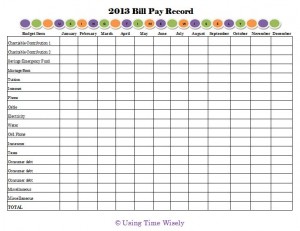Knowing that a successful year will not materialize on its own, we must plan and prepare for a prosperous 2013.
Throughout the 31 days of January, I will choose one topic each day to prepare or schedule for this year.
Without preparation, I know I will forget, miss, or overlook certain items. If you desire an organized year, then join me in this adventure of Planning for Success for a prosperous 2013.
To receive a daily e-mail around 11:00 a.m. with the new posts of each day, subscribe to my free daily newsletter. In case you miss a post in this series, I will provide the link to each day as the month progresses. 🙂
- Day 1: Select a Planning Tool
- Day 2: Add Your Priorities
- Day 3: Print and Display Your Menu Planner – with free printable
- Day 4: Record Membership Expiration Dates
- Day 5: Mark Due Dates for Monthly Bills
- Day 6: Insert Credit Report Schedule
- Day 7: Schedule Your Annual Home Maintenance
- Day 8: Set Your School and Work Activities
- Day 9: Highlight Contract and Subscription Expiration Dates
- Day 10: Download a Savings Tracker
- Day 11: Note Daily Deals Expiration Dates
- Day 12: Setup Bill Pay
- Day 13: Secure Doctor Appointments
- Day 14: Purchase Batteries
- Day 15: Include Holidays
- Day 16: Jot down Library Return Dates
- Day 17: Track Your Family’s Favorite Meals
- Day 18: Reserve Time for Your Priorities
- Day 19: Post Your Payday Schedule – with free printable
- Day 20: Prepare Your Medical Spending Record – with free printable
- Day 21: Check Light Bulbs and Air Filters
- Day 22: Choose Event Dates
- Day 23: Enter Reward Deadlines
- Day 24: Design a Quick Meals List
- Day 25: Document Family Holidays
Day 26: Verify Paycheck Deductions
In last week’s Planning for Success: Post Your Payday Schedule – Day 19, I shared how I indicate “payday and tithe (charitable contribution)” on my calendar for the scheduled day of our direct deposit. When paying the bills, I verify the paycheck deductions.
Taking less than a minute to confirm that the deductions are correct, I file the paycheck and move on. Three times a year, I take a little longer to check the amounts: first paycheck enforcing new deductions, first paycheck after changes or increases, and first paycheck after start of fiscal year.
1. First paycheck enforcing new deductions
For us, we have open or annual enrollment in October. Those changes take effect on January 1. The first paycheck stub we receive in January gets extra attention to confirm accurate deductions. If a problem arises, then we make contact with the payroll department.
2. First paycheck after changes or increases
The riders on Paul’s short-term disability insurance policy and our family’s critical illness and cancer protection policy increase each year during February. When I see an increase in deductions, I take a few moments to confirm the increased amounts based on the policy schedule. If I notice a discrepancy, I contact the policy providers to address my concerns.
3. First paycheck after start of fiscal year
Since my husband’s employer’s fiscal year does not begin in January, I review the paycheck stub more closely after the start of the new fiscal year. Any changes to retirement savings or raises adjust at that time. Any questions or concerns from that information are directed to the payroll department.
In planning for success, verify paycheck deductions by monitoring them each pay period. The investment of a little time twice a month saves time when doing taxes. If all the information is correct throughout the year, then no verification of the W-2 form is needed at tax time.
A few years ago, an employee did not look at her paycheck sub all year as her check was directly deposited into her bank account. At tax time, she panicked at the realization that none of her taxes had been paid the previous year. Had she verified her paycheck stub at least at the start of the year, she could have caught the error without backtracking.
After verifying Paul’s paycheck stub, I check off the payday notation in my calendar. Using this system reminds me to verify the information and check the deductions carefully preventing unnecessary problems later. Keep scheduling your paydays (as much as you can) while preparing for success and using time wisely. Happy verifying!
Question: How often do you verify paycheck stub deductions?






